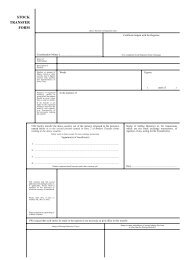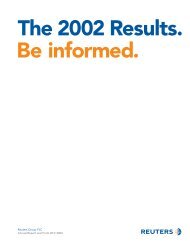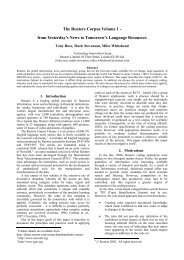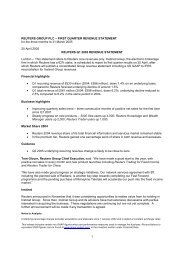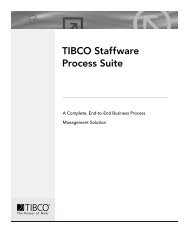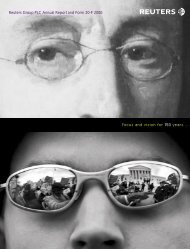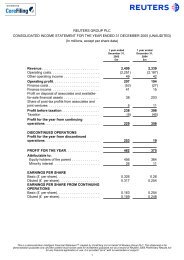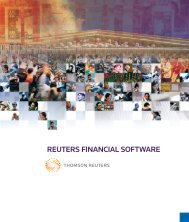REUTERS GROUP PLC ANNUAL REPORT AND ACCOUNTS 1999
REUTERS GROUP PLC ANNUAL REPORT AND ACCOUNTS 1999
REUTERS GROUP PLC ANNUAL REPORT AND ACCOUNTS 1999
You also want an ePaper? Increase the reach of your titles
YUMPU automatically turns print PDFs into web optimized ePapers that Google loves.
ownership trust compared with £7 million in1998 and £14 million in 1997. Proceeds fromthe sale of fixed asset investments was £39million, principally relating to GreenhouseFund disposals in <strong>1999</strong>.Reuters paid dividends of £207 million, up£19 million from 1998, reflecting an increasein dividends per share and a marginalincrease in the number of shares in issue.Future dividends will be based on the resultsof RI and RTS, with the intention thatpayments will be covered at least 1.7 times byunderlying earnings before goodwill as theywould have been in <strong>1999</strong>.In <strong>1999</strong> Reuters repurchased and cancelled4.7 million ordinary shares at a total cost of£25 million.Net funds at 31 December <strong>1999</strong> amounted to£41 million, compared with net debt of £3million at 31 December 1998 (1997: £1,290million net funds). Net funds at 31 December<strong>1999</strong> comprised cash and short-terminvestments of £609 million offset by grossdebt of £568 million.Reuters expects to be able to finance itscurrent business plans from existingresources and facilities.At 31 December <strong>1999</strong> Reuters Group <strong>PLC</strong>had syndicated loan facilities of £500 millionavailable which expire in December 2002, allundrawn at 31 December <strong>1999</strong>.A Euro Commercial Paper Programmeestablished in 1998 provides access to£1.5 billion in uncommitted short-termfinance, subject to market conditions. At31 December <strong>1999</strong>, Reuters had raised fundsof £188 million under this programme,repayable at various dates through toApril 2000.In 1998 Reuters also established a EuroMedium Term Note Programme whichprovides access to £1.0 billion ofuncommitted finance, subject to marketconditions. At 31 December <strong>1999</strong>, Reutershad raised funds of £259 million under thisprogramme, repayable at various dates fromFebruary 2001 up to November 2004.7. TREASURY MANAGEMENTA substantial portion of Reuters revenue iscommitted under one- and two-year contractsand approximately 80% is denominated innon-sterling currencies. Reuters also hassignificant costs denominated in foreigncurrencies with a different mix from revenue.Reuters profits are, therefore, exposed tocurrency fluctuations. The approximateproportion of operating profit excludinggoodwill amortisation and currency gainsattributable to each key currency group wasas follows:Operating profit by currency <strong>1999</strong> 1998Continental Europe– euro currencies 80% 80%– other 19% 19%US dollar 49% 54%Japanese yen 12% 13%Sterling– depreciation (52%) (59%)– other (19%) (22%)Other 11% 15%Total 100% 100%Sterling costs exceeded sterling revenues dueto the level of UK-based marketing,development, operational and centralmanagement costs and depreciation which,with the exception of Instinet, is largelyaccounted for in sterling once an asset hasbeen acquired.In broad terms using the <strong>1999</strong> mix of profits,the impact of an additional unilateral 1%strengthening of sterling would have been areduction of approximately £10 million onoperating profits before hedging (1998: £9million).Exchange rates had a small favourable impacton operating profits before hedging in <strong>1999</strong>compared with 1998.1101998100 <strong>1999</strong>199790J F M A M J J A S O N DSterling trade weighted exchangerate indexThe risk that sterling might strengthenagainst foreign currencies is hedged withinparameters laid down by the Board. Thepriority in treasury policy is to reduce the riskof year on year earnings volatility toacceptable levels while allowing a degree offlexibility to take advantage of marketmovements.The main principles underlying currencyhedging policies are as follows:• Committed hedging cannot exceed theunderlying cash flow exposure;• Options may only be written against anunderlying exposure;• Levels of cover for currency hedging cannotexceed 90% of underlying exposure for thefirst 12 months and 70% for the following12 months.The company has adopted value at risk(“VAR”) analysis as a means of quantifyingthe potential impact of exchange ratevolatility on reported earnings. VAR is ameasure of the potential loss on a portfoliowithin a specified time horizon, at a specifiedconfidence interval. Loss is defined, in thisinstance, as the diminution in value of rolling12-month forecast group profits denominatedin sterling. Due to the approximations used indetermining VAR, the theory provides orderof magnitude estimates only but these areuseful for comparison purposes.Reuters Group <strong>PLC</strong> Annual Report <strong>1999</strong> 39



